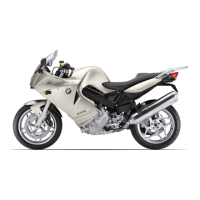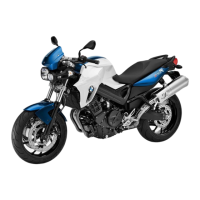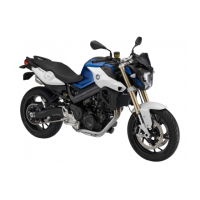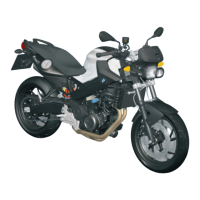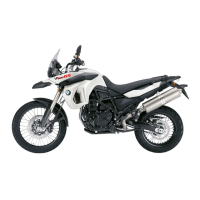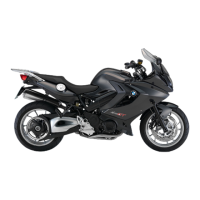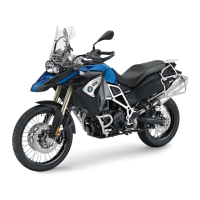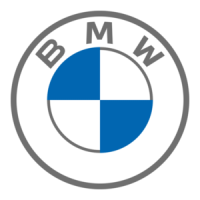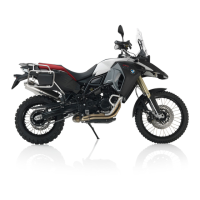Do you have a question about the BMW F 800 R and is the answer not in the manual?
Identifies and explains the functions of the left handlebar multifunction switch.
Identifies and explains the functions of the right handlebar multifunction switch.
Explains the layout and components of the motorcycle's instrument panel.
Details the various indicator and warning lights on the instrument panel and their meanings.
Explains the features and display options of the motorcycle's multifunction display.
Details specific warning lights and their implications for motorcycle operation.
Explains the operation and indications of the fuel gauge and reserve warning light.
Details the operation of the steering lock, ignition switch, and keys.
Explains the function and operation of the emergency on/off switch for engine control.
Details the function, activation, and deactivation of the Automatic Stability Control system.
Explains how to view and adjust the electronic suspension compliance settings.
Describes the different riding modes (RAIN, ROAD, DYNAMIC) and how to select them.
Describes the methods for activating the anti-theft alarm system using the remote control.
Explains how to deactivate the anti-theft alarm system and its functions.
Covers clutch lever play adjustment and brake lever operation and fluid level checks.
Outlines essential safety information, including rider's equipment and correct loading procedures.
Explains the procedure for starting the motorcycle's engine, including pre-ride checks.
Explains how to achieve shortest stopping distances and potential issues like wheel lock-up.
Covers recommended fuel quality, usable fuel quantity, and the refueling procedure.
Explains how the ABS system works, its design characteristics, and special situations.
Describes the ASC system's function, design, and special situations where it might deactivate.
Details the RDC system's operation, sensor function, and tire pressure monitoring.
Guides on checking the engine oil level, including important warnings about misinterpretation.
Covers checking brake operation, front and rear brake pad thickness, and brake fluid levels.
Covers checking tire pressure, rims, and tread depth, along with tire recommendations.
Lists common engine starting issues with their possible causes and remedies.
Details recommended fuel quality, oil specifications, capacities, and reserves.
Instructs owners on how to report safety defects to NHTSA and BMW.
Explains BMW Motorrad Service, Mobility Services, and key maintenance procedures like the Pre-Delivery Check.
Provides a detailed schedule for all required maintenance tasks based on mileage and time.
Identifies and explains the functions of the left handlebar multifunction switch.
Identifies and explains the functions of the right handlebar multifunction switch.
Explains the layout and components of the motorcycle's instrument panel.
Details the various indicator and warning lights on the instrument panel and their meanings.
Explains the features and display options of the motorcycle's multifunction display.
Details specific warning lights and their implications for motorcycle operation.
Explains the operation and indications of the fuel gauge and reserve warning light.
Details the operation of the steering lock, ignition switch, and keys.
Explains the function and operation of the emergency on/off switch for engine control.
Details the function, activation, and deactivation of the Automatic Stability Control system.
Explains how to view and adjust the electronic suspension compliance settings.
Describes the different riding modes (RAIN, ROAD, DYNAMIC) and how to select them.
Describes the methods for activating the anti-theft alarm system using the remote control.
Explains how to deactivate the anti-theft alarm system and its functions.
Covers clutch lever play adjustment and brake lever operation and fluid level checks.
Outlines essential safety information, including rider's equipment and correct loading procedures.
Explains the procedure for starting the motorcycle's engine, including pre-ride checks.
Explains how to achieve shortest stopping distances and potential issues like wheel lock-up.
Covers recommended fuel quality, usable fuel quantity, and the refueling procedure.
Explains how the ABS system works, its design characteristics, and special situations.
Describes the ASC system's function, design, and special situations where it might deactivate.
Details the RDC system's operation, sensor function, and tire pressure monitoring.
Guides on checking the engine oil level, including important warnings about misinterpretation.
Covers checking brake operation, front and rear brake pad thickness, and brake fluid levels.
Covers checking tire pressure, rims, and tread depth, along with tire recommendations.
Lists common engine starting issues with their possible causes and remedies.
Details recommended fuel quality, oil specifications, capacities, and reserves.
Instructs owners on how to report safety defects to NHTSA and BMW.
Explains BMW Motorrad Service, Mobility Services, and key maintenance procedures like the Pre-Delivery Check.
Provides a detailed schedule for all required maintenance tasks based on mileage and time.
| Engine Type | Liquid-cooled, 4-stroke parallel twin |
|---|---|
| Displacement | 798 cc |
| Power | 90 hp (66 kW) @ 8, 000 rpm |
| Transmission | 6-speed |
| ABS | Standard |
| Fuel System | Electronic fuel injection |
| Torque | 86 Nm (63 lb-ft) @ 5, 800 rpm |
| Front Suspension | 43 mm telescopic fork |
| Front Brakes | Dual 320 mm discs, 4-piston calipers |
| Rear Brakes | Single 265 mm disc, single-piston caliper |
| Fuel Capacity | 16 l |
| Dry Weight | 177 kg |
| Rear Suspension | Double-sided swing arm, central spring strut, spring preload adjustable |



